Intermediate Algebra
Tutorial 21:
Systems of LinearEquationsand Problem Solving
 Learning Objectives Learning Objectives |
After completing this tutorial, you should be able to: - Use Polya's four step process to solve various problems involvingsystemsof linear equations in both two and three variables.
|
 Introduction Introduction |
| Hey, lucky you, we have another tutorial on wordproblems. Asmentioned before, whether you like it or not, whether you are going tobe a mother, father, teacher, computer programmer, scientist,researcher,business owner, coach, mathematician, manager, doctor,lawyer,banker (the list can go on and on), problem solving iseverywhere. Some people think that you either can do it or you can't. Contraryto that belief, it can be a learned trade. Even the best athletesand musicians had some coaching along the way and lots of practice -that'swhat it also takes to be good at problem solving. The word problems in this section all involve setting upa system oflinear equations to help solve the problem. Basically, wearecombining the concepts from allrolled up into one tutorial. We will be looking at differenttypesof word problems involving such ideas as distance, percentages, andsomethingwe can all relate to MONEY!!! |
 Tutorial Tutorial |
Polya's Four Step Process
for Problem Solving
(revisited) |
| This is the exact same process for problem solving thatwas introducedin Tutorial 8: Introduction toProblemSolving. The difference is in this tutorial we will besettingup a system of linear equations as opposed to just working with oneequation. |
| Step 1: Understand the problem. |
| Sometimes the problem lies in understanding theproblem. If you are unclear as to what needs to be solved, then you are probablygoing to get the wrong results. In order to show an understandingof the problem you of course need to read the problem carefully. Sounds simple enough, but some people jump the gun and try to startsolvingthe problem before they have read the whole problem. Once theproblemis read, you need to list out all the components and data that areinvolved.This is where you will be assigning your variables. In the problems on this page,we will be lettingeach unknown be a separate variable. So, if you havetwounknowns, you will have two variables, xand y. If you have three unknowns, you will have three variables, x, y,and z. |
| Step 2: Devise a plan (translate). |
| When you devise a plan (translate), you come upwith a way tosolve the problem. Setting up an equation, drawing a diagram, andmaking a chart are all ways that you can go about solving yourproblem. In this tutorial, we will be setting up equations for eachproblem. You will translate them just like we did in Tutorial2: Algebraic Expressions and Tutorial5: Properties of Real Numbers. In the problems on this page, wewill be settingup systems of linear equations. The number of equations need tomatchthe number of unknowns. For example, if you have twovariables,then you will need two equations. If you have three variables,thenyou will need three equations. |
| Step 3: Carry out the plan (solve). |
| The next step, carry out the plan (solve), isbig. This is whereyou solve the system of equations you came up with in your devise aplanstep. The equations in the systems in this tutorial will all belinearequations. If you need help solving them, by all means, go or Tutorial 20:Solving Systemsof Linear Equations in Three Variables and review the concepts. |
| Step 4: Look back (checkand interpret). |
| You may be familiar with the expression don't lookback. In problemsolving it is good to look back (check and interpret).. Basically,check to see if you used all your information and that the answer makessense. If your answer does check out make sure that you writeyourfinal answer with the correct labeling. |
 Example1: The sum of three numbers is 14. Thelargest is 4 times the smallest, while the sum of the smallest andtwicethe largest is 18. Find the numbers. Example1: The sum of three numbers is 14. Thelargest is 4 times the smallest, while the sum of the smallest andtwicethe largest is 18. Find the numbers. |
| Step 1: Understandthe problem. |
| Make sure that you read the question carefully severaltimes. Since we are looking for three numbers, we willlet
| x = the smallestnumber y = middle number z = the largestnumber | |
| Step 2: Devisea plan (translate). |
| Since we have three unknowns,we need to builda system with three equations. Equation (1):  Equation (2):  Equation (3):  |
| Putting the three equations together in a system weget: 
|
| Step 3: Carryout the plan (solve). |
This is a system of linear equations with threevariables, which canbe found in Tutorial 20: Solving Systems of Linear Equations in Three Variables.
Simplify and put all threeequations in theform Ax + By + Cz = D if needed. Equation (2) needs to be put in the correct form: |
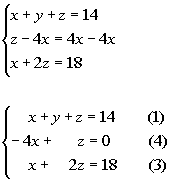 |
*Inverse of add 4xis sub. 4x
|
| Choose to eliminate any one ofthe variablesfrom any pair of equations. Since y is alreadyeliminated in equation(4) and (3), it would be quickest and easiest to eliminate y. We can use equation (4) as one equation with yeliminated: |
 | *yis alreadyeliminated |
Eliminate the SAME variablechosen in step2 from any other pair of equations, creating a system of two equationsand 2 unknowns.
We can use equation (3) as another equation with yeliminated: |
 | *yis alreadyeliminated |
| Solve the remaining systemfound in step 2and 3. Putting those two equations together we get: |
| I’m going to choose to eliminate z. Multiplying equation (4) by -2 and then adding thatto equation (3)we get: |
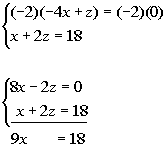 | *Mult. both sides of eq. (4)by -2
*z'shave oppositecoefficients *z'sdropped out |
 |
*Inverse of mult. by 9 is div. by 9 |
| Using equation (4) to plug 2 in forxand solving for z we get: |
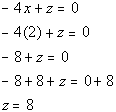 | *Equation (4)
*Plug in 2 for x
*Inverse of sub. 8 is add 8
|
| Solve for the third variable. Using equation (1) to plug in 2 forxand 8 for z and solving for ywe get: |
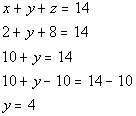 | *Equation (1)
*Plug in 2 forx and 8 for z
*Inverse of add 10 is sub. 10
|
| Step 4: Lookback (checkand interpret). |
You will find that if you plug the ordered triple (2,4, 8) into ALLTHREE equations of the original system, this is a solution to ALLTHREE of them.
Final Answer:
2 is the smallest number, 4 is the middle number and 8is the largestnumber. |
 Example2: How many gallons of 20% alcoholsolutionand 50% alcohol solution must be mixed to get 9 gallons of 30% alcoholsolution? Example2: How many gallons of 20% alcoholsolutionand 50% alcohol solution must be mixed to get 9 gallons of 30% alcoholsolution? |
| Step 1: Understandthe problem. |
| Make sure that you read the question carefully severaltimes. Since we are looking for two different amounts, we willlet
| x = the numberof gallons of 20% alcoholsolution y = the number ofgallons of 50% alcoholsolution | |
| Step 2: Devisea plan (translate). |
| Since we have two unknowns, weneed to builda system with two equations. Equation (1):  Equation (2):  |
| Putting the two equations together in a system weget: 
|
| Step 3: Carryout the plan (solve). |
| This is a system of linear equations with twovariables, which canbe found in Tutorial 19: SolvingSystems of Linear Equations in Two Variables. Simplify if needed. We can simplify this by multiplying both sides ofequation (2) by10 and getting rid of the decimals: |
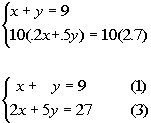 |
*Mult. both sides of eq. (2) by 10
|
At this point, you can use anymethod that youwant to solve this system. I’m going to use the eliminationmethod as discussed in Tutorial 19: Solving Systems of Linear Equationsin Two Variables.
Multiply one or both equationsby a numberthat will create opposite coefficients for either x or y if needed ANDadd the equations. If we multiply equation (1) by -2,then the x’swill have opposite coefficients. Multiplying equations (1) by -2and then addingthat to equation (3) we get: |
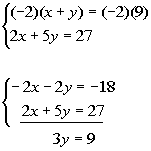 | *Mult. both side of eq. (1) by-2
*x'shave oppositecoefficients
*x'sdropped out |
| Solve for remaining variable. Solving for y we get: |
 |
*Inverse of mult. by 3 is divideby 3 |
| Solve for second variable. Using equation (1) to plug in 3 for yand solving for x we get: |
 | *Equation (1)
*Plug in 3 for y *Inverse of add 3 is sub. 3
|
| Step 4: Lookback (checkand interpret). |
You will find that if you plug the ordered pair (6, 3)into BOTH equationsof the original system, that this is a solution to BOTH of them.
Final Answer:
6 gallons of 20% solution and 3 gallons of 50% solution |
 Example3: An airplane flying with the wind cancovera certain distance in 2 hours. The return trip against the windtakes2.5 hours. How fast is the plane and what is the speed of theair,if the one-way distance is 600 miles? Example3: An airplane flying with the wind cancovera certain distance in 2 hours. The return trip against the windtakes2.5 hours. How fast is the plane and what is the speed of theair,if the one-way distance is 600 miles? |
| Step 1: Understandthe problem. |
| Make sure that you read the question carefully severaltimes. Since we are looking for two different rates, we willlet
| x = rate of theplane y = the rate ofthe wind | Since this is a rate/distance problem, it might be goodto organizeour information using the distance formula. Keep in mind that the wind speed is affecting theoverall speed. When the plane is with the wind, it will be goingfaster. Thatrate will be x + y. When the plane is going against the wind, it will begoing slower. That rate will be x -y.
| | (Rate) | (Time) | = Distance | | With wind | x + y | 2 | 600 | | Against wind | x - y | 2.5 | 600 | |
| Step 2: Devisea plan (translate). |
| Since we have two unknowns, weneed to builda system with two equations. Equation (1):  Equation (2):  |
| Putting the two equations together in a system weget: 
|
| Step 3: Carryout the plan (solve). |
| This is a system of linear equations with twovariables, which canbe found in Tutorial 19: SolvingSystems of Linear Equations in Two Variable. Simplify if needed. We can simplify this by dividing both sides ofequation (1) by 2and equation (2) by 2.5 getting rid of the ( ) and decimals at the sametime: |
 | *Div. both side of eq. (1) by 2 *Div. both sides of eq. (2) by2.5
|
At this point, you can use anymethod that youwant to solve this system. I’m going to use the eliminationmethod as discussed in Tutorial 19: Solving Systems of Linear Equationsin Two Variables.
Multiply one or both equationsby a numberthat will create opposite coefficients for either x or y if needed ANDadd the equations. Since we already have oppositecoefficientson y, we can go right into adding equations (3) and (4) together: |
 |
*y'shave oppositecoefficients *y'sdropped out |
| Solve for remaining variable. Solving for x we get: |
 | *Inverse of div. by 2 is mult.by 2 |
| Solve for second variable. Using equation (3) to plug in 270 for x and solvingfor y we get: |
 | *Equation (3)
*Plug in 270 for x
*Inverse of add 270 is sub. 270 |
| Step 4: Lookback (checkand interpret). |
| You will find that if you plug the ordered pair (270,30) into BOTHequations of the original system, this is a solution to BOTH of them. Final Answer:
The airplane speed is 270 mph and the air speed is 30 mph |
 Example4: Given the cost function C(x)and the revenue function R(x), find thenumberof units x that must be sold to breakeven. Example4: Given the cost function C(x)and the revenue function R(x), find thenumberof units x that must be sold to breakeven. C(x) = 20x+50000
R(x) = 25x |
| Step 1: Understandthe problem. |
| Make sure that you read the question carefully severaltimes. We will let,
| x = the numberof units C(x) = 20x+ 50000 R(x) = 25x | This problem appears a little different because of thefunction notation.Keep in mind that function notation translates to being y. |
| Step 2: Devisea plan (translate). |
| In this problem, the twoequations that we areworking with have already been given to us: Cost function:
C(x) = 20x+ 50000 Revenue function:
R(x) = 25x |
| Putting the two equations together in a system weget: Since the break-even point iswhen revenue= cost, we will go right into setting this up using the substitutionmethod as discussed in Tutorial 19: Solving Systems of Linear Equationsin Two Variables. 
|
| Step 3: Carryout the plan (solve). |
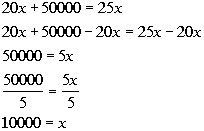 | *Inverse of add 20xis sub. 20x
*Inverse of mult. by 5 is div.by 5 |
| Step 4: Lookback (checkand interpret). |
You will find that if you plug 10000 for xinto BOTH equations that they BOTH come out to be 250000, which meansthisis the break-even point.
Final Answer:
10000 units are needed to break-even |
 Practice Problems Practice Problems |
| These are practice problems to help bring you to thenext level. It will allow you to check and see if you have an understanding ofthesetypes of problems. Math works just likeanythingelse, if you want to get good at it, then you need to practiceit. Even the best athletes and musicians had help along the way and lots ofpractice, practice, practice, to get good at their sport or instrument. In fact there is no such thing as too much practice. To get the most out of these, you should work theproblem out onyour own and then check your answer by clicking on the link for theanswer/discussionfor that problem. At the link you will find the answeras well as any steps that went into finding that answer. |
 PracticeProblems 1a - 1c: PracticeProblems 1a - 1c: Solve. |
1a. The larger of two numbers is 5 more thantwice the smaller. If the smaller is subtracted from the larger, the result is 12. Findthe numbers.
(answer/discussionto 1a) |
1b. It takes a boat 2 hours to travel 24 milesdownstream and3 hours to travel 18 miles upstream. What is the speed of theboatin still water and of the current of the river?
(answer/discussionto 1b) |
1c. A student has money in three accounts thatpay 5%, 7%, and8%, in annual interest. She has three times as much invested at8%as she does at 5%. If the total amount she has invested is $1600and her interest for the year comes to $115, how much money does shehavein each account?
(answer/discussionto 1c) |
 Need Extra Help on These Topics? Need Extra Help on These Topics? |
There were no good websitesfound to helpus with the topics on this page.
forsomemore suggestions. |
All contents
Jan. 7, 2002 |
 Example1: The sum of three numbers is 14. Thelargest is 4 times the smallest, while the sum of the smallest andtwicethe largest is 18. Find the numbers.
Example1: The sum of three numbers is 14. Thelargest is 4 times the smallest, while the sum of the smallest andtwicethe largest is 18. Find the numbers.




















